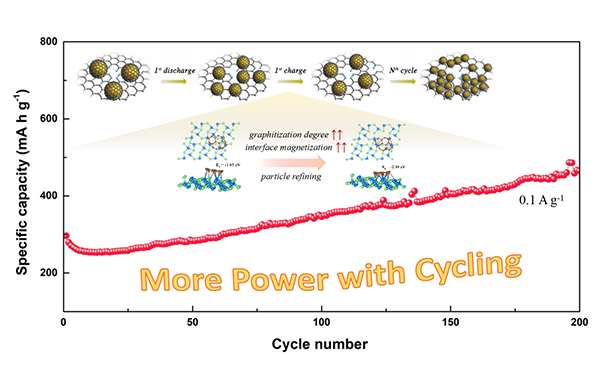Particle Refinement Induces and Increases Cycle Capacity of Sodium/lithium-ion Batteries
来源:
时间:2021-10-09 栏目类别:News
Owing to the attractive features of abundant sodium source and low cost, sodium ion batteries (SIBs) have attracted wide attention and rapid development as a research hotspot. Electrodes with higher Na+ storage capability and cycling stability are vital to improve the energy density and rate capability of SIBs.
Recently, Prof. LI Xianfeng's and Associate Prof. ZHENG Qiong's group from the Dalian Institute of Chemical Physics (DICP) of the Chinese Academy of Sciences (CAS), in collaboration with Prof. TANG Yongfu's group from Yanshan University proposed a new mechanism of sodium/lithium ion batteries electrode energy storage.
This study was published in Angewandte Chemie International Edition on Sep. 14.

Schematic diagram of the mechanism of particle refinement to induce increase the cycle capacity of SIBs (Image by WANG Canpei)
The researchers designed a coral-like FeP composite with FeP nanoparticles anchored and dispersed on a nitrogen-doped three-dimensional carbon framework (FeP@NC). The coral-like FeP@NC composite had a shorter charge transfer path and a higher conductive N-doped carbon network, which improved the charge transfer kinetics of this composite.
Due to the highly continuous N-doped carbon framework and a spring-buffering graphitized carbon layer around the FeP nanoparticle, the SIB with FeP@NC composite exhibited an ultra-stable cycling performance at 10 A g-1 with a capacity retention of 82.0% in 10000 cycles.
More importantly, they combined electrochemical research and in-situ electron microscopy characterization to confirm a unique mechanism of particle refinement to induce increase capacity during cycling, and this capacity-enhancing effect was more pronounced under small currents.
They found that the FeP nanoparticles went through a refining-recombination process during the first cycle and presented a global refining trend after dozens of cycles, which resulted in a gradually increase in graphitization degree and interface magnetization, and further provided more extra active sites for Na+ storage and contributes to a rising capacity with cycling. The capacity ascending phenomenon could also extend to lithium-ion batteries (LIBs). It can maintain a capacity retention of 90.3% for LIBs after 5000 cycles at 10 A g-1.
This work was supported by the National Natural Science Foundation of China and the Youth Innovation Promotion Association of CAS. (Text by WANG Canpei)



